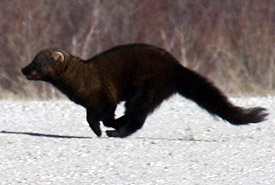An inordinate fondness for weasels

Fisher, Clear Creek, Riding Mountain Aspen Parkland Natural Area, Manitoba (Photo by NCC)
I suppose I’ve always been a cheerleader for the underdog so it’s only logical that I am a fan of the Fisher (Mustela pennanti). Weighing between seven and 13 pounds, fishers are the second-largest of North American weasels. Like their larger cousin, the wolverine, they are seldom seen, little known and very much misunderstood.
When I was growing up back in the 60s, the fisher was practically a mythological creature — a rare denizen of far northern hinterlands. The prevailing notion among outdoors folks was that fishers needed remote wilderness and were extremely sensitive to human disturbance.
Fast-forward 50 years: freed from the pressures of fur trapping, and fishers have pushed back into southern latitudes. Today this magnificent mammal can even be found in suburban backyards and farm bushlots; wherever there is sufficient woodland connectedness to allow them to move between forest patches.
My first encounter with a fisher occurred in 1971 on the north shore of Lake Superior. It was late August or early September, and some of the trees were already losing their leaves. I was walking along a forest trail when I ran face-to-face with a large fisher.
I expected him to run. Instead, he started to play hide-and-seek with me, burrowing into a basin of dead leaves and then jumping up to surprise me, racing around in a circle and then burrowing again. We carried on this game for 10 minutes or more, though he was better at it than I since there really weren’t enough leaves for me to hide in!
Like all the members of the mustelid family, fishers can be playful. As intelligent, complex predators, play is an important component of learning not just for young weasels but for adults as well. I’ve seen long-tailed weasels, short-tailed weasels, mink, marten, river otter and fisher all revel in a good game of tag. And of course, hide-and-seek!
These days I encounter fishers regularly in my wanderings through the forests of eastern Ontario. Last fall I saw three in one day on the Frontenac Arch, north of Kingston! Even when seen, they remain phantoms — moving stealthily through the forest, slipping from shadow to shadow, looking for the squirrels, snowshoe hares and porcupines that make up most of their diet.
Like other phantom creatures, fishers have a bad reputation. We tend to denigrate those species we don’t see and don’t understand. When the subject of fishers comes up, the two things I hear most frequently are that they were “bred in a secret facility in Algonquin Park and released in Eastern Ontario by the Ministry of Natural Resources and Forestry,” and that fishers “kill thousands of cats every year.”
There is so much material to work with there!
However, let me allay all fears on both counts: recent genetics studies by biologists from Trent University have revealed that eastern Ontario fishers came mostly from the Adirondacks of northern New York State, crossing the St. Lawrence River and making them the poster animal for habitat connection and wildlife corridors. And an extensive diet study of fishers around Syracuse, New York, found not a single cat hair in the hundreds of scat that were analyzed; only squirrels and hares and porcupines.
One final note: I say that fishers are my favourite mammal, but I probably say that because I’ve never seen a wolverine in the wild. Someday I hope to remedy that situation and, with a little luck, play hide-and-seek with the ultimate phantom.


